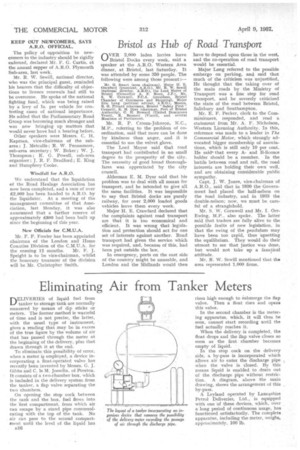Eliminating Air from Tanker Meters
Page 50

If you've noticed an error in this article please click here to report it so we can fix it.
DELIVERIES of liquid fuel from tanker to storage tank are normally measured by means of dip sticks or meters. The former method is wasteful of time and is not precise, the latter, with the usual type of instrument, gives a reading that may be in excess of the true figure by the volume of air that has passed through the meter at the beginning of the delivery, plus that drawn through it at the end.
To eliminate this possibility of error, when a meter is employed, a device incorporating a float-operated valve has recently been invented by Messrs. G. J. Gibbs and C. le M. Josselin, of Preston. It consists of a two-chamber box, which is included in the delivery system from the tanker, a flap valve separating the two chambers.
On opening the stop cock between the tank and the box, fuel flows into the 'first compartment, from which air can escape by a stand pipe communicating with the top of the tank. No air can pass to the second compartment until the level of the liquid has 131.6 risen high enough to submerge the flap valve. Then a float rises and opens this valve.
In the second chamber is the metering apparatus, which, it will thus be seen, cannot start recording until the fuel actually reaches it.
When the delivery is completed, the float drops and the flap valve closes so soon as the first chamber becomes empty of liquid. • In the stop cock on the delivery side, a by-pass is incorporated which allows air to enter the discharge pipe when the valve is closed. By this means liquid is enabled to drain out of the discharge pipe without restriction. A diagram, above the main drawing, shows the arrangement of this by-pass.
A Leyland operated by Lancashire Petrol Deliveries, Ltd., is equipped with one of these devices, which, over a long period of continuous usage, has functioned satisfactorily. The complete apparatus, including the meter, weighs, approximately, 100 lb.




















































































